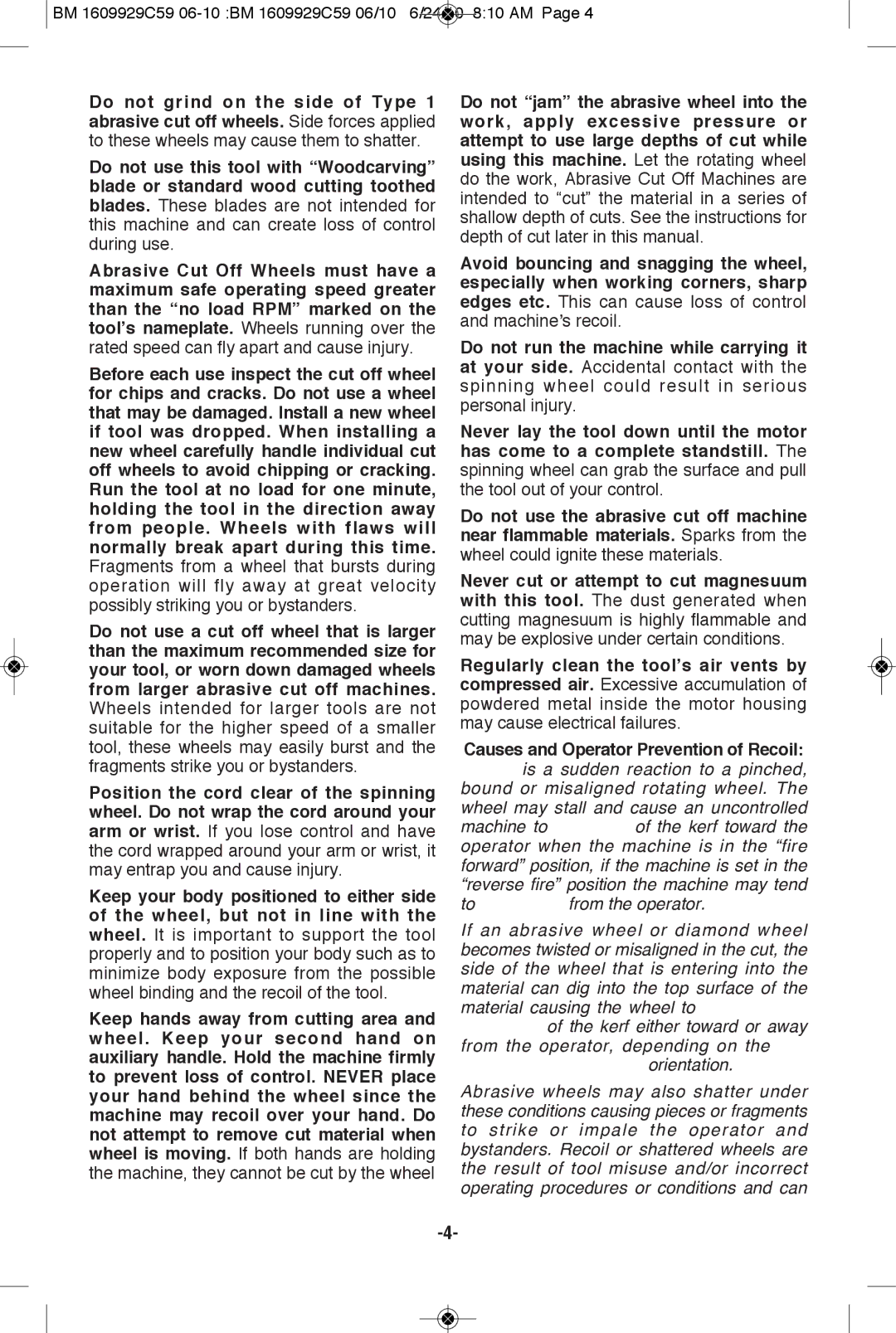
 BM 1609929C59
BM 1609929C59 06-10 :BM 1609929C59 06/10 6/24/10 8:10 AM Page 4
Do not grind on the side of Type 1 abrasive cut off wheels. Side forces applied to these wheels may cause them to shatter.
Do not use this tool with “Woodcarving” blade or standard wood cutting toothed blades. These blades are not intended for this machine and can create loss of control during use.
Abrasive Cut Off Wheels must have a maximum safe operating speed greater than the “no load RPM” marked on the tool’s nameplate. Wheels running over the rated speed can fly apart and cause injury.
Before each use inspect the cut off wheel for chips and cracks. Do not use a wheel that may be damaged. Install a new wheel if tool was dropped. When installing a new wheel carefully handle individual cut off wheels to avoid chipping or cracking. Run the tool at no load for one minute, holding the tool in the direction away from people. Wheels with flaws will normally break apart during this time. Fragments from a wheel that bursts during operation will fly away at great velocity possibly striking you or bystanders.
Do not use a cut off wheel that is larger than the maximum recommended size for your tool, or worn down damaged wheels from larger abrasive cut off machines. Wheels intended for larger tools are not suitable for the higher speed of a smaller tool, these wheels may easily burst and the fragments strike you or bystanders.
Position the cord clear of the spinning wheel. Do not wrap the cord around your arm or wrist. If you lose control and have the cord wrapped around your arm or wrist, it may entrap you and cause injury.
Keep your body positioned to either side of the wheel, but not in line with the wheel. It is important to support the tool properly and to position your body such as to minimize body exposure from the possible wheel binding and the recoil of the tool.
Keep hands away from cutting area and wheel. Keep your second hand on auxiliary handle. Hold the machine firmly to prevent loss of control. NEVER place your hand behind the wheel since the machine may recoil over your hand. Do not attempt to remove cut material when wheel is moving. If both hands are holding the machine, they cannot be cut by the wheel
Do not “jam” the abrasive wheel into the work, apply excessive pressure or attempt to use large depths of cut while using this machine. Let the rotating wheel do the work, Abrasive Cut Off Machines are intended to “cut” the material in a series of shallow depth of cuts. See the instructions for depth of cut later in this manual.
Avoid bouncing and snagging the wheel, especially when working corners, sharp edges etc. This can cause loss of control and machine’s recoil.
Do not run the machine while carrying it at your side. Accidental contact with the spinning wheel could result in serious personal injury.
Never lay the tool down until the motor has come to a complete standstill. The spinning wheel can grab the surface and pull the tool out of your control.
Do not use the abrasive cut off machine near flammable materials. Sparks from the wheel could ignite these materials.
Never cut or attempt to cut magnesuum with this tool. The dust generated when cutting magnesuum is highly flammable and may be explosive under certain conditions.
Regularly clean the tool’s air vents by compressed air. Excessive accumulation of powdered metal inside the motor housing may cause electrical failures.
Causes and Operator Prevention of Recoil: Recoil is a sudden reaction to a pinched, bound or misaligned rotating wheel. The wheel may stall and cause an uncontrolled machine to back out of the kerf toward the operator when the machine is in the “fire forward” position, if the machine is set in the “reverse fire” position the machine may tend to walk away from the operator.
If an abrasive wheel or diamond wheel becomes twisted or misaligned in the cut, the side of the wheel that is entering into the material can dig into the top surface of the material causing the wheel to climb out or recoil out of the kerf either toward or away from the operator, depending on the fire forward or reverse fire orientation.
Abrasive wheels may also shatter under these conditions causing pieces or fragments to strike or impale the operator and bystanders. Recoil or shattered wheels are the result of tool misuse and/or incorrect operating procedures or conditions and can
